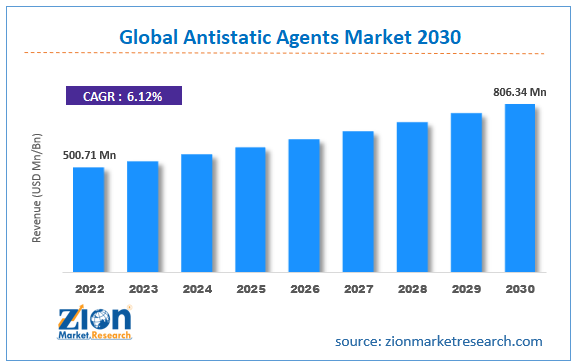Antistatic Agents Market Size, Share, Trends, Growth and Forecast 2030

The Antistatic Agents Market is focused on the production and sale of chemical compounds used to reduce or eliminate static electricity buildup on surfaces. These agents are applied to materials like plastics, textiles, and coatings to prevent static charge, which can cause dust attraction, electrical shocks, and damage to sensitive electronic components.

Get a Free Sample : https://www.zionmarketresearch.com/sample/antistatic-agents-market
1. Market Drivers
- Increasing Use of Plastics: The growing application of plastics in industries like packaging, electronics, automotive, and construction is a significant driver of the antistatic agents market.
- Growth in the Electronics Sector: The increasing demand for electronics and electronic components, where static electricity can cause significant damage, is fueling the need for antistatic agents.
- Rising Demand for Consumer Electronics: With the expansion of the consumer electronics market, particularly smartphones, tablets, and other personal devices, the need for antistatic protection is growing.
- Packaging Industry Growth: As e-commerce grows, the demand for antistatic packaging materials is increasing to ensure the safe transportation of electronics and other static-sensitive products.
2. Types of Antistatic Agents
- External Antistatic Agents: These are applied directly to the surface of materials and include agents such as surfactants.
- Internal Antistatic Agents: These are mixed into materials during production, ensuring that the antistatic properties are built into the product. Common types include fatty acid esters, quaternary ammonium salts, and alkyl sulfonates.
3. Applications
- Plastics Industry: Antistatic agents are widely used in the production of polymers like polyethylene, polypropylene, and PVC to reduce static buildup.
- Electronics: Antistatic agents are crucial in the manufacturing of electronic devices and components, helping to protect sensitive equipment from damage due to static discharge.
- Packaging: In addition to electronics packaging, antistatic agents are used in food packaging, pharmaceuticals, and industrial goods packaging to prevent dust and particulate attraction.
- Textiles: In the textile industry, antistatic agents are applied to fabrics to prevent static electricity buildup during manufacturing or consumer use.
4. Key Regions
- Asia-Pacific: This region holds the largest share of the antistatic agents market, driven by rapid industrialization, the growing electronics sector in countries like China, Japan, and South Korea, and increased plastic consumption.
- North America and Europe: The market in these regions is supported by robust electronics, automotive, and packaging industries. Strict regulations on material safety also encourage the use of antistatic agents.
- Middle East & Africa and Latin America: These regions are experiencing moderate growth due to expanding packaging and manufacturing sectors.
5. Challenges
- Environmental Concerns: Some antistatic agents, particularly those derived from petrochemicals, can have negative environmental impacts. This has led to a demand for more eco-friendly alternatives.
- Regulatory Issues: In regions like Europe, strict regulations surrounding chemical safety and environmental impact can limit the use of certain antistatic agents.
- Cost Factors: The development of high-performance antistatic agents can be costly, which might limit adoption in certain price-sensitive industries.
6. Key Players
- BASF SE
- Clariant AG
- Croda International Plc
- Evonik Industries AG
- Arkema Group
- 3M Company
- DuPont
- SABO S.p.A
7. Market Trends
- Sustainability: There is an increasing demand for biodegradable and non-toxic antistatic agents due to growing environmental awareness and regulations.
- Technological Advancements: New developments in nanotechnology and materials science are leading to more effective antistatic agents with enhanced performance and durability.
- Growth in E-Commerce: The rising demand for antistatic packaging in the e-commerce sector, especially for electronics, is a key trend driving the market.
- Focus on Automotive: As vehicles become more reliant on electronic systems, the need for antistatic materials in automotive manufacturing is increasing.
Directly Purchase a copy of the report with TOC :
8. Opportunities
- Development of Bio-based Antistatic Agents: The move towards sustainability offers opportunities for the development of bio-based antistatic agents that are both effective and environmentally friendly.
- Expansion in Emerging Economies: Growing industrialization and rising disposable income in emerging markets like India and Brazil offer potential for market expansion, particularly in the electronics and packaging sectors.
Contact Us:
Zion Market Research
USA/Canada Toll Free: 1 (855) 465–4651
Newark: 1 (302) 444–0166
Web: https://www.zionmarketresearch.com/
Blog: https://zmrblog.com/
read other report :
https://www.zionmarketresearch.com/report/heat-resistant-coating-market
https://www.zionmarketresearch.com/report/antistatic-agents-market
https://www.zionmarketresearch.com/report/vaterite-market
https://www.zionmarketresearch.com/report/next-generation-blood-gas-monitors-system-market
https://www.zionmarketresearch.com/report/automotive-windshield-washer-fluid-market


Comments
Post a Comment